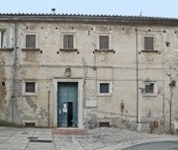



Facade in Piazza Marconi Facade in Via del Duomo
This palace was built by Bartolomeo Petrignani: his arms were removed from the main portal in the early 20th century. The finance seems to have come from his brother, Fantino Petrignani, who was Archbishop of Cosenza (in Calabria) in 1577-85. He was an official at the court of Pope Gregory XIII (and a protector of the unruly artist Caravaggio). Archbishop Petrignani died in 1601. Work on the palace stopped abruptly in 1605. Bartolomeo died in 1614, and his property passed to his nephew, Bartolomeo Ancajani. He found it incomplete and in a precarious condition, and sold it to the Monte di Pietà. The lower floors now belong to the Commune and the top floor has been adapted as residential apartments.
Work on the palace began at what is now the back, in Via del Duomo. The facade in Piazza Marconi was completed late in the project, and a planned staircase leading from the main entrance to the piano nobile was never built: the piano nobile is reached from the entrance in Via del Duomo.
Work on the frescoes of the rooms on the piano nobile began in 1572. They are difficult to attribute because almost all of them derive from engravings of well-known woks in Rome: many of these can be identified as the work of the engraver Matteo Florimi. Work seems to have started in the rooms overlooking Piazza Marconi. These frescoes are sometimes attributed to the Zuccari brothers because some of them are based on engravings of works by these artists. It is more likely that they were the work (at least in part) of Livio Agresti, who was documented in Amelia in 1572-3, and Litardo Piccioli the local artist to whom Agresti bequeathed “his paints and other things” in his will of 1575.
The most interesting frescoes include:
-
✴the frescoes in the lunettes of the Sala dello Zodiaco (the largest room on the the piano nobile), which represent allegories of the months with the associated signs of the Zodiac and which relate to the imposition of the Gregorian calendar by Fantino’s patron, Gregory XIII in 1582;
-
✴frescoes of maps of Rome, Milan, Bologna and Florence in this room, at least some of which were based on engravings by Matteo Florimi;
-
✴a fresco in Room 4 that shows Ulisse Orsini (whose mother came from the Petrignani family and who was Bishop of Ripatransone in 1653 - 1680) approaching a besieging army outside a cityscape of Amelia; and
-
✴a fresco in Room 6 that depicts the arrival of the Somaschi Fathers at Amelia, an event that was financed by the Petrignani family.
Read more:
F. Bettoni and M. Bergamini, “In Gran Parte Fantastici: gli Affreschi nelle Sale di Palazzo Petrignani ad Amelia” (2009) Terni
This page in the website of the Commune contains more information and a number of images of the frescoes in the palace.
Return to Other Patrician Palaces.
Return to Monuments of Amelia.
Return to the Walk around Amelia.

